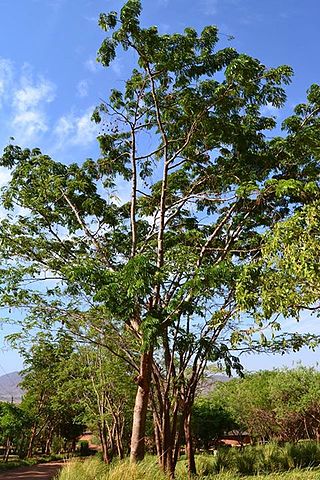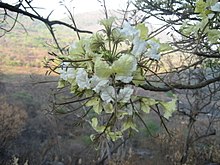Androstachys johnsonii, the Lebombo ironwood, is a medium-sized Afrotropical tree species, and the sole member of the genus Androstachys in the Picrodendraceae. It is slow-growing, evergreen to deciduous, and dioecious, with flowers that are wind-pollinated. It is native to southeastern Africa and Madagascar, where it generally occurs gregariously on rocky hillsides, particularly in hot and dry situations. It produces a hard, durable wood which is of economic interest. Its specific name commemorates W. H. Johnson, a 19th-century Director of Agriculture in Mozambique. Four related species which are native to Madagascar, are usually placed in genus Stachyandra.

Afrocarpus falcatus is a species of tree in the family Podocarpaceae. It is native to the montane forests of southern Africa, where it is distributed in Malawi, Mozambique, South Africa, and Eswatini. Common names include common yellowwood, bastard yellowwood, outeniqua yellowwood, African pine tree, weeping yew, Afrikaans: outeniekwageelhout, kalander, Sotho: mogôbagôba, Xhosa: umkhoba and Zulu: umsonti. It is widespread, in some areas abundant, and not considered threatened, but it is a protected tree in South Africa. It is grown as an ornamental tree, especially in South Africa, and occasionally abroad.

The amethyst sunbird, also called the black sunbird, is a species of passerine bird in the family Nectariniidae. It is native to the Afrotropics, mostly south of the equator. They are commonly found in well-watered habitats, and undertake seasonal movements to visit flowering woodlands. The demise of some woodlands have impacted their numbers locally, but their range has also expanded along with the spread of wooded gardens.

Southern African Sand Forest is a sand forest, or a subtropical forest plant community of the tropical and subtropical dry broadleaf forests biome. It grows on ancient sand dunes in northern KwaZulu-Natal and southern Mozambique. In South Africa these forests are known simply as Sand Forest, while in Mozambique they are known as Licuati Forest. The Southern African sand forest is part of the Maputaland coastal forest mosaic ecoregion.

Treculia africana is a tree species in the genus Treculia which can be used as a food plant and for various other traditional uses. The fruits are hard and fibrous, can be the size of a volleyball and weight up to 8.5 kg (19 lb). Chimpanzees have been observed to use tools to break the fruits into small pieces that they can eat. The fruits contain polyphenols.
Landolphia kirkii is a species of liana from the family Apocynaceae that can be found in Democratic Republic of the Congo, Malawi, Mozambique, Tanzania, Zambia, Zimbabwe, and in the KwaZulu-Natal province of South Africa.

Cordyla africana is a tall, deciduous African tree with a large, spreading, much-branched crown, and a bole of some 2.2 m dbh. It is a member of the large leguminous family Fabaceae, and is known as wild mango in some areas. It is found up to 1000m elevation in large river valleys, in miombo woodland and coastal swampy evergreen forest, mostly on sandy soils, along the eastern parts of central and southern Africa. It occurs in South Africa in KwaZulu-Natal and Mpumalanga provinces, the Kruger National Park, Eswatini, Mozambique, Zimbabwe, Zambia, Malawi, Kenya and Tanzania. 'Cordyla' is from the Greek word 'kordyle', meaning a 'club' and is a reference to the club-shaped fruit and stalk.

Combretum apiculatum is a species of tree in the family Combretaceae known by the common name red bushwillow. It is native to the mesic to semi-arid savanna regions of Africa, southwards of the equator.

Psychotria capensis, the bird-berry, is a southern African evergreen shrub or small tree. It belongs to a genus which is used medicinally in many regions, 'Psychotria' being from the Greek for 'rejuvenating', in reference to the healing properties of certain species. Kew lists some 2,000 species of Psychotria growing throughout the warmer regions of both hemispheres, but only two of them occur in southern Africa, namely P. capensis and P. zombamontana.

Maerua cafra (DC.) Pax is a small Southern African tree belonging to Capparaceae, the caper family, occurring eastwards along the coast from Knysna, then further inland and northwards through KwaZulu-Natal and Eswatini to the Transvaal, southern Mozambique and southern Zimbabwe. The genus Maerua comprises about 60 species found in Africa and Asia.

Dalbergia armata is a scrambling, deciduous species of legume that is native to subtropical to temperate regions of southeastern Africa. The robust, woody liana or small tree is armed with strong spines on the main stem and branches. It occurs sparsely or commonly in forest, bush, riparian fringes and in wooded ravines. It is sometimes employed as a bonsai subject, and it can be propagated from either seed or cuttings.

Parkia filicoidea, or African locust bean, is a large, spreading flat-crowned tree to 30 metres tall, the bole of which may be narrowly buttressed to a height of about 3 metres, and up to 120 cm DBH. It occurs in wet evergreen or semi-deciduous forest, sometimes on forest fringes, riverbanks and lakes, termite mounds, at elevations up to 1000 metres from Côte d’Ivoire, east to Sudan and Somalia, Uganda, Kenya, Malawi and south to Angola, Zambia, Zimbabwe and Mozambique. Bark on trunk scaly or smooth, grey to yellow-brown, branchlets glabrous to puberulous.

Donella viridifolia, commonly known as fluted milkwood, is a potentially large species of evergreen milkwood tree that occurs in East African coastal forests, southerly coastal forest mosaics and in some inland forests of the tropics and subtropics.

Allophylus decipiens (E.Mey.) Radlk., commonly known as the bastard taaibos, is a multi- or single-stemmed, small, evergreen tree about 3–4 m in height occurring in coastal forest, fringe forest and thickets, and wooded ravines and streams. Found up to 800 m in the southern coastal regions of the Cape Province, KwaZulu-Natal, Eswatini, along the escarpment forest of Mpumalanga, including Soutpansberg and in Mozambique. There are some 219 species in the genus of Allophylus.

Boscia foetida, commonly known as the stink shepherd's tree and the smelly shepherd's bush, is an evergreen shrub or tree that is native to the warmer and drier parts southern Africa. It is found in semi-desert and arid bushveld, and in the west it occurs commonly in areas which are otherwise sparsely wooded. It is known for the particularly unpleasant smell of its flowers which appear during early spring, to which its specific name foetida alludes. Its freshly cut wood likewise has an unpleasant smell, and has traditional medicinal and magical uses, for instance as a protection against lightning. In central Botswana the village of Mopipi is named after this species.

Brexia is a plant genus assigned to the Celastraceae. It is a dense evergreen shrub or small tree of usually around 5 m high, with alternately set, simple, leathery leaves with a short leaf stem and lanceolate to inverted egg-shaped leaf blades. The pentamerous flowers occur in cymes. The petals are greenish white, the stamens are alternating with wide, incised staminodes. The superior ovary develops in a long-ribbed fruit. Brexia naturally grows on the coast of East Africa, on Madagascar, the Comoros and Seychelles. Opinions differ about the number of species in Brexia. Sometimes the genus is regarded monotypic, B. madagascariensis being a species with a large variability, but other authors distinguish as many as twelve species. Common names for B. madagascariensis include jobiapototra, tsimiranjana, tsivavena, vahilava, voalava, voankatanana, voantalanina, voatalanina and votalanina, and mfukufuku (Swahili), mfurugudu and bwa kato (Seychelles).

Drypetes arguta, commonly known as the water ironplum, is a species of small tree or large bush in the family Putranjivaceae. It is native to tropical East Africa. It was first described in 1920 by the English botanist John Hutchinson, who named it Cyclostemon argutus. It was later transferred to the genus Drypetes.

Microcoelia exilis, commonly known as the pinhead orchid, is a species of flowering plant in the orchid family, Orchidaceae. It is a leafless epiphyte, a perennial herb that grows in a tangled cluster of roots and stems on the branch of a tree. This orchid is native to tropical central and eastern Africa and was first described in 1830 by the English botanist John Lindley.

Hewittia malabarica is a flowering plant in the monotypic genus HewittiaWight & Arn., belonging to the family Convolvulaceae and widespread throughout tropical Africa, Asia, and Polynesia. It is a climbing or prostrate perennial herb with slender stems and flowers that are pale yellow, cream, or white with a purple center, and large leaves that can be used as a cooked vegetable or used in folk medicine with the roots. The stems can be used to make ropes.


















